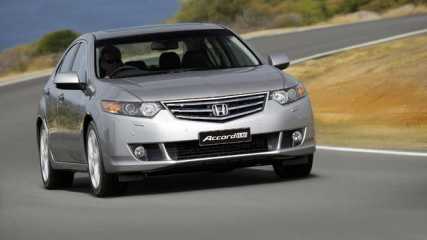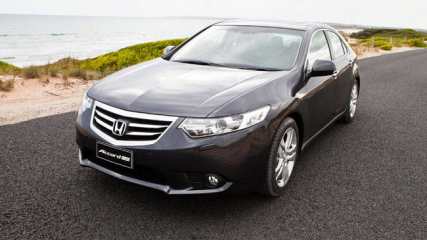Used Honda Accord Euro review: 2003-2005
By Graham Smith · 25 Jun 2009
For many years Honda was spoken of as the Asian BMW, but never has that description been more accurate than it is now with the Accord Euro leading the brand’s charge.It was generally held that Hondas were better engineered and better built. They were said to be a class above the other Japanese makes, and rivaled European brands like the sporty BMW.There wasn’t any doubt about the claims of engineering excellence and build quality, but Hondas still looked and felt like a Japanese car. They were generally bland to look at and the controls didn’t have a quality feel about them.But then something happened, the Japanese industry awoke, and their cars changed. They became more European in the intangible things that distinguish the good cars from the also-rans.The Honda Accord Euro – the name says it all – had the looks and the feel to go with the Japanese reliability and quality. It was as if the Japanese industry had realized it needed to appeal to western buyers if it wanted to succeed. All of a sudden exports were the key to long-term success.MODEL WATCH Japanese cars have built an enviable reputation for reliability and durability through the standard of their engineering and their build quality. The Japanese industry has set the pace in those regards and forced other manufacturers to lift their game, but its cars were manacled to mediocrity by stodgy styling and overtly plastic ‘cheap looking’ interiors.The classic example was the Honda NSX sports car. An awesome mid-engined sports coupe that had the performance to match the world’s great supercars, but its interior looked like it came from a humble Civic with acres of average plastic and controls that clearly came from the Honda small car parts bin.Previous Accords were good solid reliable cars, but the sixth generation Accord Euro launched in 2003 was different. It still felt light on the road, it didn’t have the solid road feel that most Europeans have, but there was little to moan about, and even the looks were attractive.Honda was clear in its focus with the Accord Euro, it was to be a performance oriented model. Anyone who wanted a more conservative ride could buy the plusher Accord V6, which was also available at Honda dealers alongside the Euro.The Accord Euro was well proportioned with appealing lines that gave it an athletic look without being too bold. But while it was an appealing car its styling was somewhat derivative; it could easily have come from Munich.There were two models in the range, the Accord and Accord Luxury, both powered by Honda’s renowned 2.4-litre double overhead camshaft i-VTEC LEV engine boasting peak power of 140 kW at 6800 revs and 223 Nm at 4500 revs.The engine used variable valve timing and electronic lift with variable inlet cam phasing for more efficient combustion with exhaust gas recirculation, better torque and more linear performance through the rev range. Backing up to the engine was a choice of a six-speed manual gearbox, which had a light, precise, short-throw shift, or a five-speed auto with a manual shift function.All of that was built on a rigid, stable platform that provided a sound foundation for the handling Honda wanted for the Accord Euro. Double wishbone independent suspension was a feature at both ends; it had massive disc brakes with anti-skid, brake force distribution and brake assist electronics to assist with the stopping. The electronic arsenal also extended to stability control and traction control in an impressive package of driver aids.Inside, the Accord had all the features expected of a prestige model, including air, cruise, power windows and mirrors, six-stack CD sound with steering wheel controls, remote keyless entry, alarm and immobiliser. On top of that the Luxury also had high-density headlights, power sunroof, power front seats, leather, woodgrain, rain sensor wipers, headlight washers and fog lamps.IN THE SHOPMake sure the Accord has been serviced, and by someone who knows the brand well. They are packed with technology and are built to close tolerances so regular servicing is essential. Oil changes in particular must be done on a regular basis.The Accord’s good build quality means little generally goes wrong with them, and they are still in their youth with just five years of road life under the tyre marks. Look for body damage, and listen for odd noises when driven.IN A CRASH The agility, road holding and braking prowess of the Accord Euro enables drivers to escape threatening situations they may face on the road if they’ve got the driving ability. Both the Accord and Accord Luxury boasted an impressive array of airbags including front and side airbags, while the Luxury had the added protection of curtain airbags. In another plus all occupants had three-point lap-sash seat belts.AT THE PUMP Owners report they get around 9.5 L/100 km average fuel consumption around town, but on a trip that drops to 7-8 L/100 km. Those figures compare quite well to the 9.2 L/100 km Honda quotes for the auto model on the ADR test.OWNERS SAY Jenny Foster loves driving her 2005 Accord Euro, and living in country Victoria she does plenty of it driving between her country home and Melbourne. She says it’s fantastic on the highway. It’s also been reasonably cheap to run, although it does require premium fuel, which it sips at the rate of 8 L/100 km on the highway. There have been no mechanical problems to date, but she is critical of the large turning circle, the blocked vision when turning, and the poor visibility when backing because of the low seating position.Daniel Madeira is the proud and happy owner of a 2005 Accord Euro. He loves its looks and the way it drives. Its handling is exceptional, he says, and he loves the option of changing gears manually on the auto transmission. His only problem has been a squeak where the windscreen meets the body, which was fixed under warranty.Nick Zouros has clocked up 47,000 km in his 2005 Accord Euro and reckons it’s a great car. The engine and auto transmission are brilliant, and the build quality, reliability and comfort are exceptional, he says. He’s critical of the firm ride at low speeds and he would like more room in the back seat for his growing family.William Martin reckons his Accord Euro is the best-finished car he’s had in his 50 years of owning motor vehicles. Its comfort and performance are first class, he says.LOOK FOR • Attractive styling• Brilliant handling• Zippy performance• Firm ride at low speeds• Good fuel economy• Requires premium fuelTHE BOTTOM LINE Soundly engineered and well built, the Accord Euro is a reliable and fun driver.RATING 80/100








